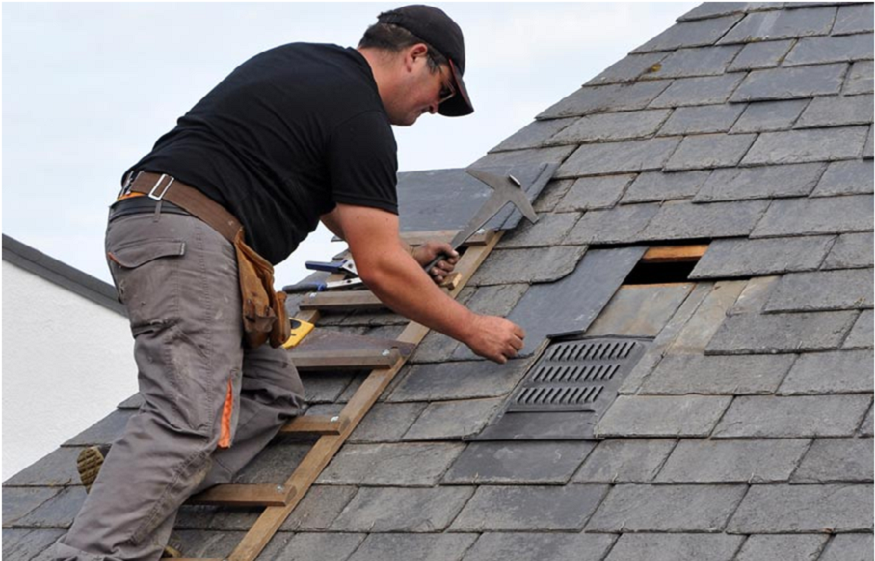The southeast United States, especially Florida, is susceptible to being struck by hurricanes and tropical storms. Over the years, hurricanes have struck all of Florida’s coast.
There is a high chance you’ve had to deal with storm damage in the past few years if you live in the south. Although roof repair can be costly and time-consuming, it is essential to address any damage quickly to avoid further complications.
What happens in a hurricane?
A hurricane is a tropical storm that forms in the warm waters of the Atlantic Ocean or Caribbean Sea. These storms can produce wind speeds up to 175 miles per hour, which can cause them to last hours. Heavy rain is often accompanied by strong winds and changes in wind direction.
Hurricanes can cause immediate damage by hail, wind, hail, falling objects like trees and utility poles, as well as heavy rains.
Wind Damage
High winds are one of the most common problems with roof repairs after a hurricane. High sustained winds from hurricanes can cause wind damage. These winds can cause roof damage by putting great pressure on it. This can lead to missing, damaged or loose shingles. It can also cause damage to fascia, metal flashing and exhaust pipes.
Wind blows in different directions during a hurricane. Wind blows in a variety of directions and speeds, and it does so at irregular speeds. This can cause a variety strains to your roof.
Wind travels upwards when it hits your walls, which causes upward pressure on the roof.
This pressure is particularly high in the corners and at the edges.
As the wind blows across the roof’s surface, negative pressure can be exerted. This can cause roofing material to lift.
Hail Damage
Hail that comes with many hurricanes can cause hail damage to siding and roofing.
Trees
Roof damage from falling branches or trees is another common problem. Trees that fall on roofs can cause severe damage such as broken tiles and shingles, punctured roofing membranes and roof framing damage.
Heavy Rain
Hurricanes can bring heavy rains, which can cause roof damage and premature aging.
Is Your Roof at Risk?
High winds can cause roof damage due to a variety of factors, including:
The roof geometry can affect how wind flows around and over the home. Hip roofs let the wind flow more freely, while roofs with large eaves are more susceptible to wind blowing upwards at walls.
How to attach the roofing material to the roof decking.
If the roof was properly installed.
If the roof is damaged or old or if it has not been properly repaired.
How to tell if your roof is damaged
After a major storm, especially one like a hurricane, it is a good idea to have your roof inspected by a professional. Although some roof damage might not be immediately apparent, it can cause major problems later.
You can check your roof for damage without the assistance of a professional. Before you go out to inspect your home for damage, wait until the storm passes.
Make sure you have a camera with you to document any problems. You can zoom in with a camera, which may help you see the extent of damage better.
These are the steps to take if your roof is damaged by a hurricane.
To schedule an inspection or roof repair, contact a professional roofing contractor
To prevent further damage to the roof, secure a temporary tarp or another roofing material if it is not damaged.
Avoid contact with downed power lines and stay safe.
For homeowner’s insurance, follow the recommendations of your roofing company.
Reduce Hurricane Damage to Roofs
It is possible to escape roof damage from a hurricane, but it is not always possible. There are steps you can take to reduce the chance that your roof will require major repairs.
Regular roof inspections
Regular roof inspections will ensure that your roof is in good condition. It is possible to miss an inspection if a hurricane is approaching. However, it is better to plan ahead than to get caught up in panic.
Tree trimming
Trees and branches that might fall onto your roof should be removed or trimmed. You never know when a branch will snap so it is important to do this every day. It is important to make sure that no large branches hang over the roof during a storm, and that all dying or unstable trees are removed.
Gutters
Storms, such as hurricanes, can bring a lot of rain to your home in a very short time. Your gutters and downspouts should be kept clear of water around your foundation. Water can back up in gutters, which can lead to damage to the roof sheathing and eaves. To prevent them from being blown away by windy conditions, make sure your gutters are securely fastened.
Hurricanes and Homeowners Insurance
The details of your homeowners insurance policy will determine whether or not you are covered for hurricane damage. You may not have coverage if you have specific provisions.
However, the majority of homeowners policies will cover some damage caused by a hurricane.
It is best to hire a professional roofing contractor to repair your roof. They can help you file the claims and provide documentation that will enable you to get your homeowners insurance benefits.
What Roofing Materials Are Best for Hurricanes and High Winds?
There are pros and cons to all roofing materials, including their ability withstand high winds like a hurricane. This information is intended to provide a general overview of wind resistance for different roofing materials. However, if you are looking at a new roof, you should consult a professional to get advice specific to your situation.
Asphalt Shingles
Asphalt shingles are the most popular roofing material used in the United States. They can be found on approximately 80% of American homes, according to the Asphalt Roof Roofing Manufacturers Association. There are many options for shingles and the wind resistance of them varies.
Standard asphalt shingles are capable of withstand winds up to 60-80 miles per hour. Architectural shingles can withstand winds up to 110 miles an hour and are more wind-resistant than standard asphalt shingles.
Asphalt shingles are classified according to wind resistance using standards from ASTM International. The majority of asphalt shingles are one of the following two types:
Metal roofing
Metal roofing can withstand wind speeds up to 140- or 150-miles an hour. Metal roofs are becoming more popular in residential and commercial settings.
Metal roofing is more expensive than asphalt, and many homeowners associations have still placed restrictions on its use. There are many new options for metal roofing that look like asphalt shingles, but offer the superior durability and strength of metal.
Metal roofing can be damaged by hail. These can cause damage to the roof’s integrity but they can make it look unattractive.
Clay tiles or concrete tiles
Clay or concrete tiles are more resilient to hurricanes than concrete tiles, but they are also heavier and therefore harder to lift. However, properly installed tiles provide excellent wind resistance. There are also two drawbacks.
Concrete tile or clay are generally more expensive.
The high winds of hurricanes can blow tiles off, making them more dangerous than asphalt shingles.
Remember that roofing materials can be damaged by hurricanes. You should choose a roofing material that can withstand strong winds and is durable if you live in an area susceptible to hurricanes.
Lakeland’s Best Roofing Services
HD Roofing of FL is the best choice for residential and commercial roofing repairs, as well as any other roofing services. Our team of experts is dedicated to providing the best service, materials and warranties in the business.
For a free inspection, or to discuss your specific roofing requirements, contact us today.
This article was written by a roofing and solar installation specialist at HD Roofing & Construction. At https://hdroofers.com/, our roofing team is the heart of the company, and we are proud to have a highly-trained, professional team. If you need a roof over your head, we’ve got you covered. We offer a variety of roofing and home improvement services, including roof replacement and repairs, emergency tarps, home restoration, and solar!


SLS принтеры: цены и возможности
sls принтер купить https://pgrt3d-lss.ru .
Инновационные решения для вашего бизнеса
Изготовление прототипов с помощью 3D печати металлом на заказ в Москве
3D печать металлом на заказ в Москве https://3d-pechtmet.ru .
Кольский полуостров: отдых, который вы заслужили
тур на семгу на кольский http://www.tury-na-kolskii-poluostrov.ru .
Вызвать сантехника на дом: качественный сервис, доступные цены
сантехник срочно http://www.vizov-santekhnika-spb.ru/ .
Сантехник срочно на дом: оперативное решение ваших проблем
сантехник спб http://vizov-santekhnika.ru/ .
Покупка диплома: Полезные советы как не нарваться на мошенников
купить диплом в москве https://www.diplom-01.ru/ .
Не откладывайте на потом: вызовите сантехника прямо сейчас
услуги сантехника https://spb-vizov-santekhnika.ru/ .
Срочный вызов сантехника: быстро и эффективно решаем любые проблемы
вызвать сантехника спб https://www.santehmontaz-2.ru/ .
Join the High Stakes Action in the Best Poker Game Online!
casino video poker https://www.casinowild-24.com/games-guide/video-poker-guide/ .
Готовим без глютена: вкусные и безопасные рецепты
нету рецепта https://brkgrp.ru .
Лучшие магазины
Выбор 3D принтера для промышленного использования
купить промышленный 3d принтер http://prm-3dinter.ru/ .
video poker online for free [url=http://www.casinowild-24.com/free-casinos/free-video-poker/]video poker online for free[/url] .
Как выбрать КПП для спецтехники: полезные советы от экспертов
кпп автобуса xn—–klcfasajgfzrae3as6cp0o.xn--p1ai .
Эксклюзивные предложения на кпп для спецтехники: Скидки и акции
кпп фронтальные погрузчики http://www.xn—–klcfasajgfzrae3as6cp0o.xn--p1ai .
Магазины посуды: посетите нас и удивитесь разнообразию
магазины посуды http://lenta.ru/conf/krichever/ .
roulette online live roulette online live .
Key Features to Look for in Anti-Spoofing Software
antispoofing https://dataset-anti-spoofing.com/ .
Стоимость фулфилмент услуг: инвестиции, которые окупаются
фулфилмент прайс https://www.fulfilment-moskva77.ru/ .
Эффективные стратегии
Арбитраж трафика через соцсети: советы и рекомендации
трафик тизерная сеть тизерные сети 2023 .